Dandelions are notorious and difficult to control. In lawns they invasively compete with grass for available resources and if nothing is done they will completely take over your lawn. Applying a weed killer is one of the best strategy for getting rid of dandelions in your lawn. In this guide we have highlighted and reviewed the best dandelion killer that won’t kill your grass.
Best Dandelion Killer – That Won’t Kill Grass
With plenty of weed killers out there, it can be difficult to choose the right one for controlling weeds in your lawn without killing your grasses. We have selected the most effective safe on grass formulas you can use to get rid of those stubborn dandelions in your lawn and garden.
1. Ortho Weed B Gon Plus Crabgrass Control
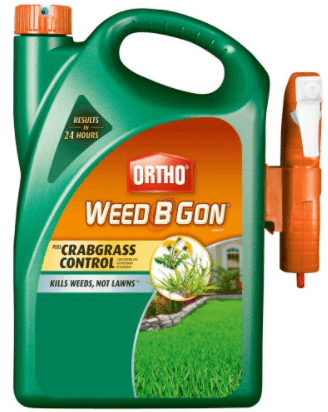
Ortho Weed B Gon Plus Crabgrass Control kills many broadleaf and stubborn grass weeds in lawns including crabgrass, dandelions and more. This formula starts working immediately in a single application and kills weeds to the root without harming grass.
This formula is perfect for spot treatment, small and large lawns. It is available in both concentrate and ready to use forms. Concentrate can be diluted and use with a tank sprayer while ready to use package come with a sprayer for instant use.
This weed killer is designed for use on Bermudagrass, Buffalograss, Fescues, Kentucky Bluegrass, Perennial Ryegrass, and Zoysiagrass. Avoid using on St. Augustine Floratam lawns. Carefully read and follow label directions for effectiveness and safety.
2. PBI/Gordon Speed Zone Lawn Weed Killer
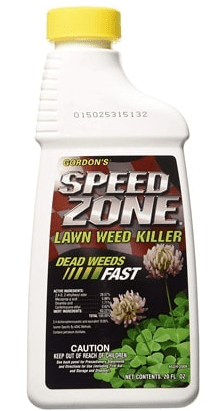
This is a selective and effective weed killer for common and troublesome weed species in lawns. It controls clover, ground ivy, wild violets, creeping Charlie, dandelions and other tough lawn weeds without harming grass.
PBI/Gordon Speed Zone Lawn Weed Killer contains 2, 4-D ingredients that immediately attacks the weed from the outside and kills it to the root over a couple of weeks. Further, this herbicide can also prevent broadleaf weeds from sprouting.
It is recommended for use on: Perennial ryegrass, Bermudagrass, Kentucky bluegrass, Fescues, Zoysiagrass. The 20 ounce bottle contains enough concentrate to cover 14,000 to 18,200 sq. ft. of lawn when diluted. Do not over-apply and always read and follow label instructions.
3. Southern Ag Amine 2,4-D WEED KILLER
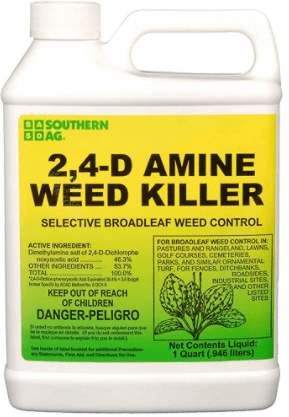
This is a selective pre and post-emergent herbicide that targets broadleaf weeds such as dandelion, clover, chickweed among others. It does not kill grasses and thus suitable for lawns, pastures, rangelands and along fences.
Southern Ag Amine 2,4-D WEED KILLER can take weeks to completely kill the weeds and the results will be lasting. This inexpensive formula uses the 2, 4-D ingredient, which is highly effective against weed and can be used for spot treatment or on entire lawn.
Be careful when using on St. Augustine grass. A stronger solution or over-applying on an area can harm your grass. Properly follow label instructions on how to dilute and the type of grasses to use on. With proper dilution, 32 ounce bottle can cover up to 20,000 sq. ft. of lawn.
4. Spectracide Weed Stop For Lawns Plus Crabgrass Killer Concentrate
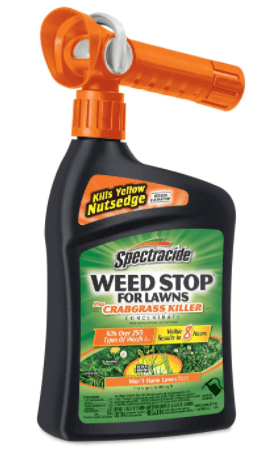
This is an effective product that targets broadleaf and troublesome grass weeds including crabgrass, dandelion, chickweed and clover foxtail and yellow nutsedge among others. Spectracide Weed Stop For Lawns Plus Crabgrass Killer Concentrate does not harm lawn grass when used as directed.
The 32 ounce bottle treats up to 5,000 square feet and results can be seen within 8 hours of application. Rainfall or watering 3 hours after spraying will not affect its effectiveness. This product should be applied daytime when temperatures are between 45°F and 90°F. Avoid using on Bermuda grass when temperatures exceed 85°F. Like most weed killers, you are advised not to use it on St. Augustine
5. Bonide Ready To Use Chickweed, Clover and Oxalis Weed Killer
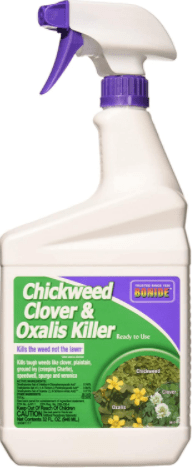
This a fast acting formula for getting rid of variety of weeds in your lawn without killing grasses. When applied as directed, Bonide Ready To Use weed killer targets broadleaf weeds to the root. Among many other weeds, it completely eliminates chickweed, clover, dandelions, ground ivy, oxalis and wild violet.
The formula is available in ready to use form and concentrate which you can dilute to cover large areas. Depending on the type of weeds, time for results may vary. Some weeds die within 24 hours while others take up to 2 weeks. To get good results ensure the weeds are completely soaked and the lawn is not mowed 1 to 2 days before or after use.
How to Choose the Best Weed Killer for your Lawn
Weed killers come in variety of formulas whose effectiveness if based on where you use, when you apply and the type of weed you are targeting. Even with the best weed killer, a successful weed control will depend on the following factors.
1. Plant Selectivity
Weed killers can either be selective or non-selective. Selective weed killers are formulated to kill certain types of weed or grasses, without affecting your turf grass. Non-selective weed killers on the other hand kill most type of plants including lawn grasses.
When choosing a weed killer, be sure to check selectivity so that do don’t end up killing your lawn grasses. Take note of the type of grasses or plants the herbicide can be used on before fully using it on your lawn or garden.
2. Weeds emergent
The stage of weed growth should help you choosing either a pre-emergent or post-emergent herbicide. If you want to get rid of weeds that are already growing, you will need to use a post-emergent herbicide. They are formulated to control weeds that have already emerged out of soil and already growing.
Post-emergent weed killer is applied directly on the leaves and stems of the visible weeds in your lawn, garden or cracks. The chemical will destroy the foliage, stem or roots system thus permanently clearing weeds.
Pre-emergent weed killer also known as preventer is applied on lawns or gardens to target germinating weeds which have not sprout out of the soil. The chemical will stop seed germination and prevent any weed from growing in your yard. Pre-emergent weed preventers have a residual effect of 6-8 weeks thus you won’t be able to reseed the area immediately.
3. Herbicide translocation
This describes how the chemical moves within the weed once it is absorbed through the leaves, stem or roots. A weed killer can either be contact or systemic. Contact chemicals only affect part of the plant they have come in contact with. This means for effective outcome, apply on every part of the weed plant.
Systemic weed killer is absorbed into the plant via leaves or roots and gets carried to every part as it denatures the cells. Although a slow action, the herbicide effectively kills the entire plant. Systemic herbicides are the best for controlling perennial weeds which are notorious at growing back.
4. Types of weeds
Various weed killers are formulated for a specific type of weed and thus very important to understand the nature of weeds you are dealing with. Broadleaf weeds and grassy weeds are common types of weeds in lawns and gardens.
Broadleaf weeds have visible wide large leaves and you can easily distinguish them from your grass. They thrive in low nutrients soils and common in areas where grass has thinned or struggling. Examples of broadleaf weeds are dandelions, oxalis, spurge, clover, plantain, wild onion, wild garlic, and clover among others.
Grassy weeds resemble common grass and it’s usually difficult to control them. Common grassy weeds in lawns include crabgrass, dallisgrass, creeping bentgrass, foxtail, quackgrass, and goosegrass among others. Getting rid of crabgrass in particular is a very difficult and you have to use both pre-emergent and post-emergent herbicides in controlling it.
5. Herbicide Formulation
A weed killer can be in granular or liquid form. Liquid herbicides are usually mixed with water and applied using a sprayer. Granular herbicides on the other hand are usually mixed with inert carrier such as clay or fertilized carrier and spread from a fertilizer spreader.
How to apply a weed killer on lawn
- Before you make any step, carefully read and follow label instructions.
- Stick to safety guidelines to avoid potential spray drift problems
- Use plastic sheeting to protect your flowerbeds and other wanted plants
- Spray away from children and pets
- For adequate absorption and leaf contact do not mow the lawn 2 to 3 days before spraying
- The best time to apply a herbicide is when the weather is cool with without rain or winds
- To target only weeds that you want to eliminate, use a foam applicator
- Wear personal protective gear to prevent inhaling it or contact with your skin and eyes
- Clean your sprayer before loading it with a weed killer solution
- Ensure the sprayer is in good condition without any leaking problems
- Maintain a spray height of about 2 feet above the plant for maximum coverage and prevention of a potential drifting.
- Use the correct application nozzle as directed on the product label
- Apply granulated herbicide when the weed foliage is wet with dew or after irrigation
- Spot treat if there are only few areas in your lawn with weed problems
- Don’t irrigate treated lawn within 24 hours of herbicide application
- Thoroughly clean off all the equipment after done with spraying
Final Thoughts
Using a weed killer is not always a solution to weeds problem. It can affect your soil and makes it unsuitable for proper growth of plants. Further, chemical herbicides affect other helpful lives in the lawn. Proper soil preparation before planting, watering, good fertilizer and mowing are enough at preventing weeds in your lawn.
Although formulated for plants, weed killers are also a potential hazard to human beings and other animals. It is not recommended to use on edibles such as fruits and vegetable. Spraying should be done away from pets and children and whoever applying should wear a protective gear.
There are also natural ways of getting rid of weeds in lawns without killing grass or affecting other plants. Example is manually uprooting the weeds or solarizing them. These methods may be cumbersome and only work when there are only few spots of weeds in the lawn.